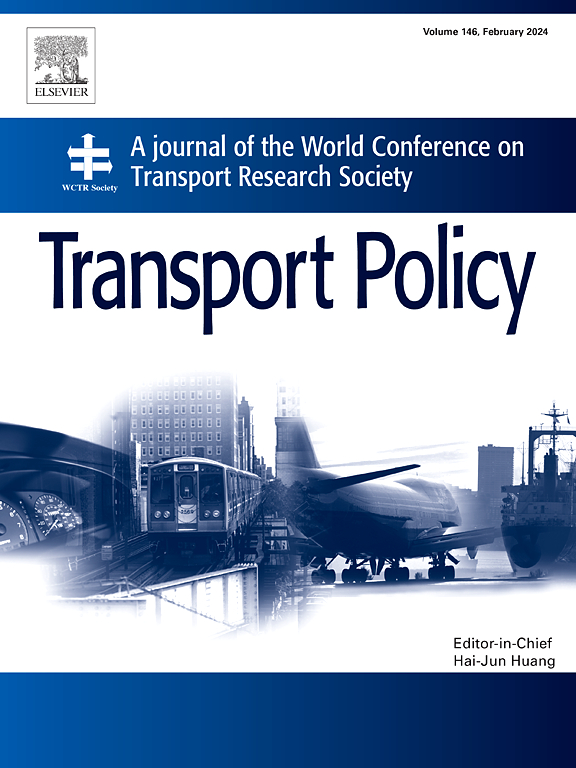多级治理和模式思维:欧洲城市电动交通转型中的紧张关系
IF 6.3
2区 工程技术
Q1 ECONOMICS
引用次数: 0
摘要
在转型研究中,围绕电动汽车(EV)技术的创新被视为快速实现交通系统脱碳的可行途径。然而,形成这些转型的流动历史和路径依赖在空间上是不平衡的,在不同地域之间是横向的,在不同权力和责任范围之间是纵向的。因此,它们植根于城市和大都市治理政策过程中的假设和权力关系。本研究采用了一种新颖的方法,对这些过程在城市之间进行横向比较,在各级政府之间进行纵向比较。分析基于 50 次专家访谈,访谈对象是欧洲四个城市中参与电动交通相关政策实施的地方和国家参与者:这四个城市是:英国布里斯托尔、挪威奥斯陆、波兰波兹南和荷兰乌得勒支。在所有这四个城市中,国家、国家间和超国家的压力使一些受访者认为向电动交通,尤其是私家车电动化过渡是不可避免的。然而,由于模式思维渗透到城市交通决策中,我们的大多数专家将可持续和公正的城市交通定义为涉及私家车以外的交通模式。本研究的主要贡献在于揭示了国家电动汽车优先事项与城市减少汽车交通量目标之间的矛盾,这种矛盾潜移默化地影响着地方决策者对电动交通转型的看法。这项研究还为城市和大都市决策者如何以更具包容性、创新性和地方响应性的方式制定政策,以适应电动汽车和电动滑板车等新型交通方式提供了新的见解。本文章由计算机程序翻译,如有差异,请以英文原文为准。
Multi-level governance and modal thinking: Tensions in electric mobility transitions in European cities
Innovations around electric vehicle (EV) technology are viewed as a promising pathway to rapidly decarbonise transport systems in transition studies. However, the mobility histories and path dependencies that shape these transitions are spatially uneven both horizontally across different geographies and vertically between different scales of authority and responsibility. As such, they are rooted in the assumptions and power relations that underlay the policy processes of city and metropolitan governance. This study takes the novel approach of comparing these processes both horizontally between cities and vertically between levels of government. The analysis is based on 50 expert interviews with local and national actors involved in delivering policy related to electric mobility in four European cities: Bristol, United Kingdom; Oslo, Norway; Poznań, Poland, and Utrecht, Netherlands. In all four cities, national, inter- and supra-national pressures generate a perception among some interviewees that the transition to electric mobility, and particularly the electrification of private cars, is inevitable. Yet because modal thinking permeates urban transport policymaking, the majority of our experts define sustainable and just urban mobility as that involving modes other than the private car. A key contribution of this study is revealing this tension between national EV priorities and urban aims to reduce car traffic, which subconsciously influences local policymakers’ perceptions of the transition to electric mobility. The study also offers new insights into how city and metropolitan policymakers can be more inclusive, innovative, and locally-responsive in shaping policies for accommodating both EVs and new modes like e-scooters.
求助全文
通过发布文献求助,成功后即可免费获取论文全文。
去求助
来源期刊

Transport Policy
Multiple-
CiteScore
12.10
自引率
10.30%
发文量
282
期刊介绍:
Transport Policy is an international journal aimed at bridging the gap between theory and practice in transport. Its subject areas reflect the concerns of policymakers in government, industry, voluntary organisations and the public at large, providing independent, original and rigorous analysis to understand how policy decisions have been taken, monitor their effects, and suggest how they may be improved. The journal treats the transport sector comprehensively, and in the context of other sectors including energy, housing, industry and planning. All modes are covered: land, sea and air; road and rail; public and private; motorised and non-motorised; passenger and freight.
 求助内容:
求助内容: 应助结果提醒方式:
应助结果提醒方式:


